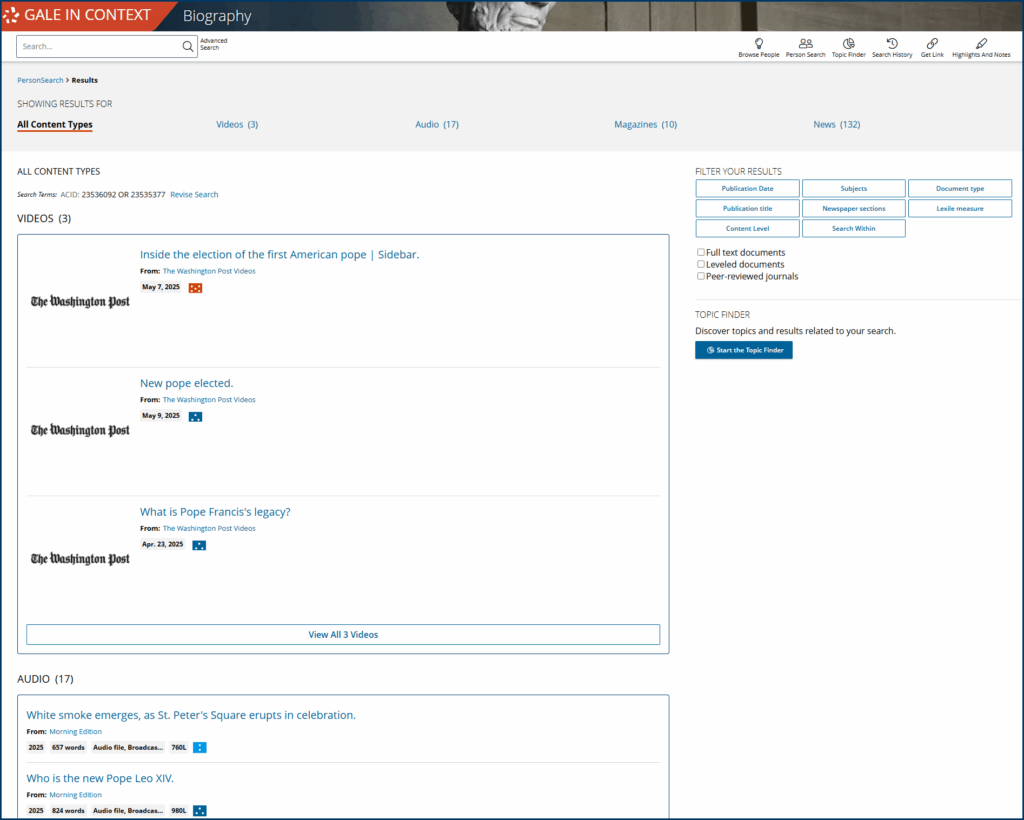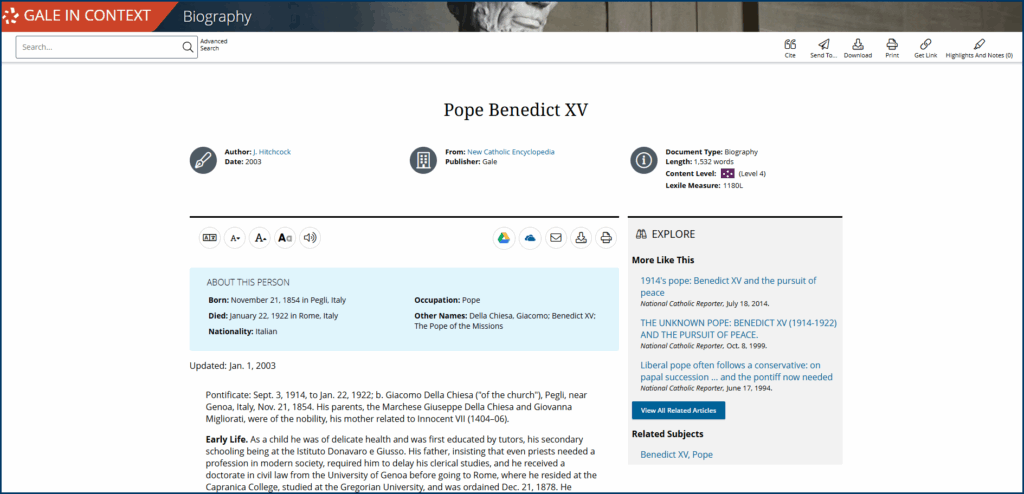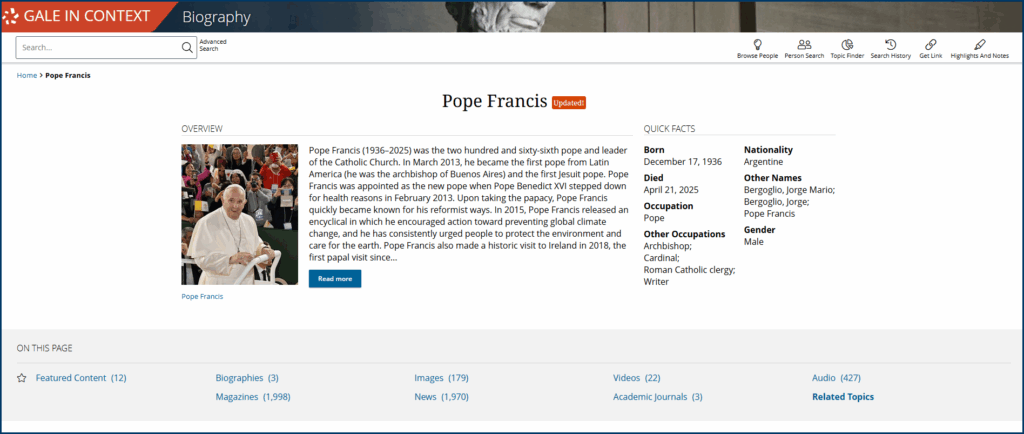| By Gale Staff |
On May 8, the College of Cardinals elected Robert Francis Prevost the 268th pope of the Roman Catholic Church—the Church’s first-ever American pope. Although Pope Leo XIV, hails from a working-class background in Chicago, his journey to the Vatican bridges multiple continents, cultures, and languages.
For the classroom, Prevost’s ascendancy to the Cathedra Petri is a case study in how the currents of global change can force even the largest and oldest institutions to adjust course. The papacy is one of the oldest offices in the Western world—steeped in tradition, and resistant to disruption. Yet this appointment reflects a shift in who holds influence within it. It demonstrates how an institution can adhere to its core teachings while accommodating leadership that reflects a broader, global community.
This article serves as a classroom toolbox: a collection of research themes, discussion questions, and source-linked prompts that help educators turn the election of Pope Leo XIV into a meaningful academic investigation. From the symbolism of papal names to the evolving role of the Catholic Church on the world stage, each section offers an entry point for student engagement grounded in trusted content from Gale In Context: Biography.
The Papacy on the World Stage
Though popes are elected as spiritual leaders, they also operate as heads of state. Vatican City is a sovereign entity with diplomatic relations in more than 180 countries, and the pope regularly engages with presidents, peace negotiators, and religious leaders from across the world.
Historically, popes have intervened in global conflicts and served as mediators in diplomatic efforts. Pope Benedict XV called for ceasefires during World War I and proposed peace terms when other powers refused to negotiate.
Following his election in 1978, Pope John Paul II returned to Poland, where he lent the weight of his office to workers pushing back against Soviet control. Over the next decade, his pilgrimages—from Manila to Mexico City—carried messages of peace and reconciliation well beyond church walls. Subsequent writing addressed issues ranging from global conflicts to the treatment of refugees, demonstrating how the pope’s words could further influence public debate even without direct political power.
From Working Class Roots to the Vatican
Born in Chicago to a working-class family, Robert Prevost answered his calling as an Augustinian and, after ordination, served for two decades in Peru, where he holds dual citizenship.
As bishop of Chiclayo, Peru, Prevost was known for hands-on leadership in moments of crisis. During the 2023 floods caused by Cyclone Yaku, he joined relief efforts, delivering supplies and wading through waist-high water to assist displaced families. In response to the COVID-19 pandemic, he raised funds to build two oxygen plants for local hospitals. Prevost also founded diocesan commissions to combat human trafficking and established services to help Venezuelan refugees access housing and residency documents. Those experiences sharpened his diplomatic acumen and, coupled with his formative training in North America, positioned him to lead with uncommon global credibility.
Within weeks of his election, Pope Leo XIV met privately with Ukrainian President Volodymyr Zelensky—his first in-person meeting since his inauguration Mass—calling for “a just and lasting peace” in Ukraine.
Research Pathway
Encourage students to explore how past popes brought their personal histories into public leadership. Using Gale In Context: Biography, they can examine how life experiences—whether forged in war, diplomacy, or displacement—influenced how different popes navigated moments of international crisis.
Here are a few interesting figures worth further investigation:
- Pope Paul VI: With experience in Vatican diplomacy and international travel, he was the first pope to address the United Nations, calling for peace during the Vietnam War and Cold War.
- Pope Pius XII: A former papal nuncio to Germany and later Vatican secretary of state before his election in 1939. Vatican archives have fueled intense scholarly debate over whether his silence in the face of Nazi atrocities was strategic restraint or moral failure. He is one of the most contested figures in modern Church history.
- Pope Urban VIII: A Renaissance-era pope whose political alliances shaped the Church’s position in the Thirty Years’ War and negotiations with emerging European powers.
Critical Thinking Questions:
- How did the background of each pope shape the conflicts or causes they chose to speak about?
- In what ways do popes act as moral authorities on the global stage—even without formal political power?
What’s in a Name?
When a new pope is elected, one of his first acts is to choose a new name, a tradition that dates back to Pope John II in the sixth century. Known as Mercurius prior to his elevation as pope, he decided that it would be inappropriate to carry the name of a Roman god into the Church’s highest office. Every pope since has followed suit, selecting names that reflect theological commitments and legacies they hope to carry on.
Leo
By choosing the name Leo XIV, Pope Leo deliberately aligned himself with two influential predecessors who also bore the name. Pope Leo I (440–61), known as Leo the Great, defined foundational Church doctrines during the fifth century and asserted the spiritual authority of Rome as the Western Empire was in decline. Centuries later, Pope Leo XIII issued Rerum Novarum in 1891, the first major papal encyclical to address the rights and dignity of workers.
Francis
Pope Francis (2013–25) broke with tradition by selecting a previously unused name, honoring St. Francis of Assisi. Known for his humility, poverty, and concern for the marginalized, St. Francis inspired a vision of the Church grounded in compassion rather than hierarchy, an ethos Pope Francis embodied throughout his papacy.
John
The name John, the most commonly chosen papal name, originated with Pope John I (523–26), who balanced loyalty to the emperor with his pastoral duties during a period of tension. This spirit of diplomacy was exemplified by Pope John XXIII (1958–63), who convened the Second Vatican Council to modernize the Church’s relationship with the world.
Gregory
Pope Gregory I (590–604), known as Gregory the Great, led the Church through the collapse of the Roman Empire, asserting spiritual authority and expanding mission work. Almost a millennium later, Pope Gregory XIII (1572–85) reinforced that legacy through the Gregorian calendar reform and investment in Catholic education, strengthening the Church’s global influence during the Counter-Reformation.
The Unwritten Rule
According to tradition, Christ appointed the apostle Peter as the rock upon which the Church would be built, making him the first bishop of Rome and the first pope. Out of respect, no subsequent pontiff has ever chosen Peter as a papal name.
Research Pathway
Ask students to select a papal name and trace its lineage through history. Encourage them to consider the following:
- How did each pope’s historical context shape their interpretation of the legacy associated with their chosen name?
- What challenges or expectations might arise when a new pope chooses a name strongly associated with a previous pope’s legacy?
- How can studying the evolution of papal names over time reveal changes in the Church’s values and priorities?
American Catholics in Leadership
For much of the United States’ early history, Catholics made up a small, often isolated minority, largely confined to pockets in urban centers across the Northeast and in regions like Maryland. However, as the nation expanded in the 19th century, waves of Catholic immigrants—especially from Ireland, Italy, and Germany—arrived in large numbers.
This influx sparked a backlash from many Protestant Americans who viewed Catholics with suspicion over concerns about their perceived loyalty to the pope. Such beliefs led to movements like the Know-Nothings openly opposing Catholic participation in politics and Catholic churches and schools becoming frequent targets of violence.
In 1928, Al Smith became the first Catholic to secure the Democratic nomination despite widespread prejudice. It wasn’t until 1960 that John F. Kennedy finally broke through as the first Catholic elected president of the United States.
In a landmark speech to the Greater Houston Ministerial Association, Kennedy confronted anti-Catholic prejudice head-on, assuring voters that his decisions would be guided by the nation’s interests rather than his own religious beliefs. He famously stated, “I am not the Catholic candidate for president. I am the Democratic Party’s candidate for president who happens also to be a Catholic.”
Pope Leo XIV’s election as the first American-born pope offers a timely opportunity for students to explore this complex history—and to consider how religious identity continues to shape public life in the United States.
Research Pathway
Using Gale In Context: Biography, students can examine how American Catholics have shaped the nation’s political landscape by influencing major legislative and judicial outcomes.
- John F. Kennedy: The nation’s 35th president (1961–63). Launched landmark initiatives like the Peace Corps.
- Robert F. Kennedy: US attorney general (1961–64) and US senator (1965–68). Led civil rights enforcement and anti-poverty efforts.
- Nancy Pelosi: Speaker of the House of Representatives (2007–2011, 2019–2023). First woman to hold that office and driver of legislation such as the Affordable Care Act.
- Joe Biden: The nation’s 46th president (2021–25). Guided the country through pandemic relief and infrastructure investment.
- J.D. Vance: Vice president (2025–present). Cosponsored the Affordable Connectivity Program to bring high-speed internet to underserved areas.
- Sonia Sotomayor: US Supreme Court justice (2009–present). First Latina on the Court; authored key opinions on voting rights and criminal justice.
Critical Thinking Questions:
- In what ways have Catholic politicians helped reframe public perceptions of religion in American governance across different historical periods?
- What does the election of Pope Leo XIV suggest about shifting global and national narratives of Catholic leadership? How might it reshape political and cultural expectations moving forward?
Exploring the lives of leaders like Pope Leo XIV allows us to understand how they have been shaped by the world around them—and how they, in turn, shape the world. It reveals how personal experience intersects with power and how even centuries-old institutions evolve through human decisions.
Gale In Context: Biography facilitates these exercises in critical thinking by ensuring students are working with educator-vetted materials from respected sources. Its curated content helps learners connect personal histories to broader political, cultural, and institutional movements, making it easier for educators to build rigorous, relevant lessons that meet today’s research standards.
To learn how Gale In Context: Biography can support your teaching, contact your Gale representative.




